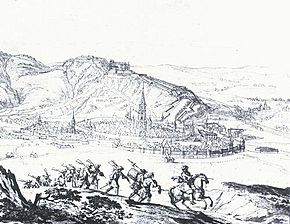Siege of Freiburg (1677) facts for kids
Quick facts for kids Siege of Freiburg |
|||||||
|---|---|---|---|---|---|---|---|
| Part of the Franco-Dutch War | |||||||
 |
|||||||
|
|||||||
| Belligerents | |||||||
| Commanders and leaders | |||||||
| François de Créquy | Charles of Lorraine Georg von Schütz zu Purschütz |
||||||
| Strength | |||||||
| 20.000 | 2.800 | ||||||
| Casualties and losses | |||||||
| 1.000 | 200 | ||||||
The Siege of Freiburg was a big battle that happened between November 9 and 16, 1677. It was part of a larger conflict called the Franco-Dutch War. During this siege, the city of Freiburg was attacked and taken over by French forces. This event was a major victory for France.
Contents
The Siege of Freiburg
Why the Battle Happened
Towards the end of 1677, armies usually stopped fighting for the winter. They would go to their winter camps. But French Marshal François de Créquy had a different idea. He wrote to King Louis XIV in Paris, saying it was a good chance to capture Freiburg. The King agreed to this surprise winter attack.
On November 8, Créquy and his soldiers crossed the Rhine River near Breisach. They marched quickly towards Freiburg. By 8 AM on November 9, they had reached the city, ready to begin the siege.
The leader of the other side, Charles of Lorraine, tried to get his army ready again. But it was hard to gather his scattered troops. The roads were bad, and some groups of soldiers did not want to keep fighting in the cold.
The Fight for the City
On November 10, the French army began to attack. Créquy started firing cannons at a part of the city called Neuburg. At the same time, another French commander, Meinhardt Schomberg, attacked the Freiburg Charterhouse near the Schlossberg hill.
During the night of November 10-11, a brave officer named Colonel Kaunitz led a small attack. He tried to stop the French from digging trenches closer to the city. On November 11, Freiburg faced heavy cannon fire, but the city did not get too much damage. Kaunitz made another daring move to try and break through the French lines. He also sent messengers to the Duke of Lorraine, asking for help.
By November 12, the French cannons had made a huge hole, over 30 meters wide, in Neuburg's city wall. Créquy then asked Freiburg to give up. But the city's commander, Schütz, refused. His officers told him not to surrender. From November 12 to 13, the French kept digging their trenches closer. They also made the hole in the wall even bigger.
The City Gives Up
On November 14, at 4 PM, Commander Schütz decided to give up the suburbs. The French had not even started to storm the broken wall yet. The French soldiers then moved into the suburbs. Créquy again asked the city to surrender. Commander Schütz seemed unsure what to do. The Austrian government even asked someone else to take command, but they refused.
Meanwhile, the French were able to get their positions ready without trouble. They prepared to fire cannons at the inner walls of Freiburg.
On November 15, the French got ready to attack the Christopher Gate. They also managed to capture the walls on the Schlossberg hill. From this high point, they could shoot down at the city's defenders. Créquy even brought more cannons to the top of the Schlossberg for a better attack. Later that day, the French made a hole in the Christopher Gate. Commander Schütz then told the French he wanted to talk about surrendering. A ceasefire began.
Créquy said that the city and its castle had to be handed over by 8 AM on November 16. After dark, people in Freiburg heard gunshots from a nearby stronghold. This was a sign that help was coming. During the night, messengers arrived from Hermann of Baden-Baden. He was coming with more Imperial troops and promised to be in Freiburg by evening.
Inside Freiburg, there was a lot of confusion. The city leaders, the Austrian government, and the officers disagreed. But Commander Schütz was determined to surrender. On November 16, before 8 AM, the surrender document was signed. The Austrian soldiers were allowed to leave with their weapons. They went to Rheinfelden. The French promised to protect the lives and property of the citizens. However, both Imperial and French troops ended up looting Freiburg. The Imperial soldiers left at 1 PM. The main French army entered the city on November 17.
What Happened Next
When Charles of Lorraine heard that Freiburg had given up, he ordered Commander Schütz to be arrested. Schütz was put on trial in Vienna. He was found not guilty, even though there were signs that he might have helped the French. Some people believed that Louis XIV tried to influence officials in other countries. Schütz's acquittal was thought to be because of a powerful person in Vienna, Johann Paul Hocher, who was related to Schütz.
In France, taking Freiburg was seen as a huge victory. A special coin was made to remember the event. The French turned Freiburg into a strong fortress. They even tore down some parts of the city to do this. In the Peace of Nijmegen treaty, the Habsburgs gave up Freiburg. The city remained French until 1698.
Sources
- F. L. Dammert: Freiburg in der zweiten Hälfte des XVII. Jahrhunderts. VI. Wie die Stadt Freiburg französisch wurde. In: Zeitschrift der Gesellschaft für Beförderung der Geschichts-, Altertums- und Volkskunde, 6. Band, Freiburg im Breisgau 1887, pages 3–157 Digitalised by UB Freiburg
- F. L. Dammert: Bericht des Ratschreibers D. Franz Karl Vogel über die Belagerung und Übergabe der Stadt Freiburg im November 1677. In: Zeitschrift der Gesellschaft für Beförderung der Geschichts-, Altertums- und Volkskunde, 6. Band, Freiburg im Breisgau 1887, pages 379–393 Digitalised by UB Freiburg

